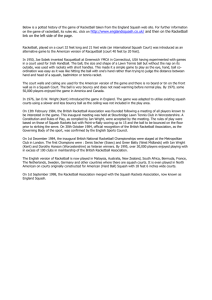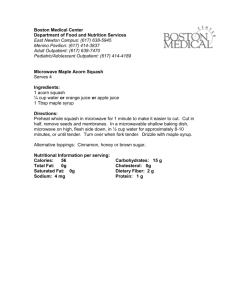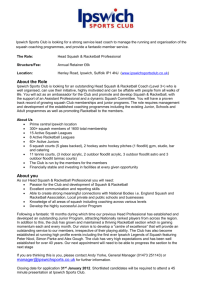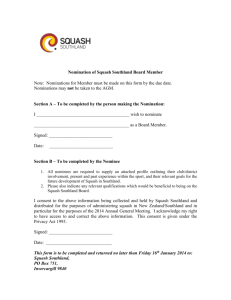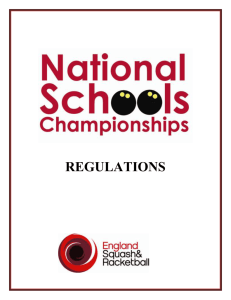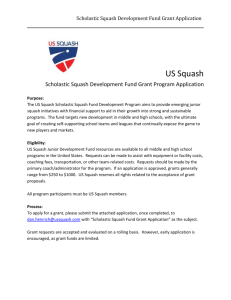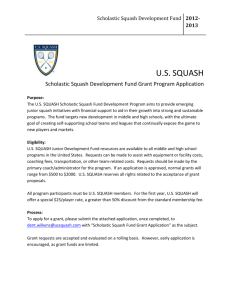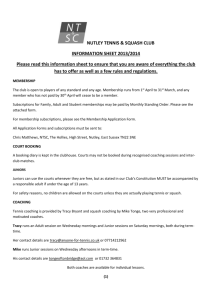Tech_Sheet_1a-_Building.Feb14
advertisement
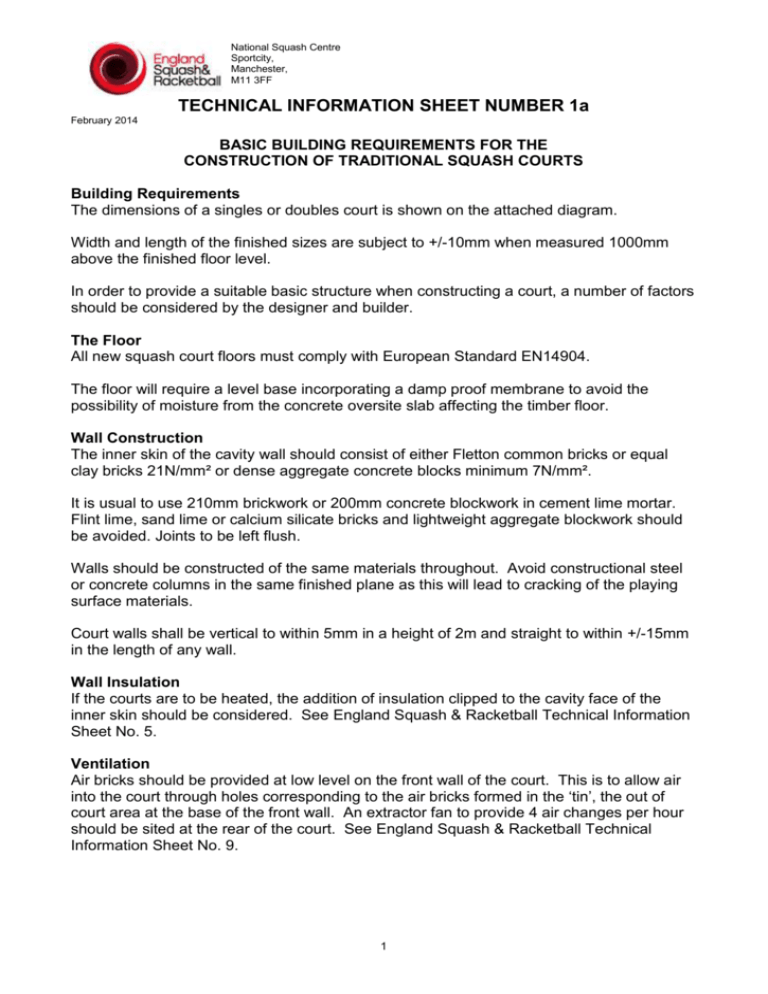
National Squash Centre Sportcity, Manchester, M11 3FF TECHNICAL INFORMATION SHEET NUMBER 1a February 2014 BASIC BUILDING REQUIREMENTS FOR THE CONSTRUCTION OF TRADITIONAL SQUASH COURTS Building Requirements The dimensions of a singles or doubles court is shown on the attached diagram. Width and length of the finished sizes are subject to +/-10mm when measured 1000mm above the finished floor level. In order to provide a suitable basic structure when constructing a court, a number of factors should be considered by the designer and builder. The Floor All new squash court floors must comply with European Standard EN14904. The floor will require a level base incorporating a damp proof membrane to avoid the possibility of moisture from the concrete oversite slab affecting the timber floor. Wall Construction The inner skin of the cavity wall should consist of either Fletton common bricks or equal clay bricks 21N/mm² or dense aggregate concrete blocks minimum 7N/mm². It is usual to use 210mm brickwork or 200mm concrete blockwork in cement lime mortar. Flint lime, sand lime or calcium silicate bricks and lightweight aggregate blockwork should be avoided. Joints to be left flush. Walls should be constructed of the same materials throughout. Avoid constructional steel or concrete columns in the same finished plane as this will lead to cracking of the playing surface materials. Court walls shall be vertical to within 5mm in a height of 2m and straight to within +/-15mm in the length of any wall. Wall Insulation If the courts are to be heated, the addition of insulation clipped to the cavity face of the inner skin should be considered. See England Squash & Racketball Technical Information Sheet No. 5. Ventilation Air bricks should be provided at low level on the front wall of the court. This is to allow air into the court through holes corresponding to the air bricks formed in the ‘tin’, the out of court area at the base of the front wall. An extractor fan to provide 4 air changes per hour should be sited at the rear of the court. See England Squash & Racketball Technical Information Sheet No. 9. 1 National Squash Centre Sportcity, Manchester, M11 3FF TECHNICAL INFORMATION SHEET NUMBER 1a February 2014 Out of Court Area Wall surfaces above the playing surfaces may be left as fair faced work for decoration in a light colour. The Door England Squash & Racketball recommend that for all new build traditional brick built squash courts, the Standard wooden solid core door at 915mm width should be fitted as this will allow access for wheelchair users. Alternatively, for normal use, a door with a clear opening size of 800mm to comply with current Building Regulations. The access door of the court is sited on the centre line, or middle third of the back wall. The frame is set flush with the playing surface. A flush door with a solid core is painted and hung on concealed hinges SOSS pattern. A check action closer and door viewer is fitted. Glass Back Wall Where a glass back wall is to be installed, the supporting channels are set into the side walls. Fins are supported on metal angles bolted into the concrete floor slab which should be thickened to allow for the bolts. The door width should be 914mm to allow access for wheelchair users or a door with a clear opening size of 800mm to comply with Building Regulations. Viewing Gallery Where a solid back wall is used, a viewing gallery over the access corridor should be provided for spectators and referee/marker. Ceiling The ceiling of the court should preferably be flush with no projecting beams. The ceiling and/or underside of the roof, if exposed, should be painted a light colour. Playing Surfaces These are defined with concave or angled out of court battens 50mm wide. A number of playing surface materials are available and these are applied by specialist contractors who are approved by the manufacturer of the wall surface materials. Normal plasters are not suitable for squash courts. Playing surfaces are left undecorated. Floors Either maple or beech strips of a consistently light colour, secret nailed to semi-sprung battens at 300mm centres for maple and 411 mm for beech. Strips are laid the length of the court. The floor surface is left unsealed with a slight ‘nap’ to provide shoe traction for the players. Lighting For lighting requirements for squash courts, please see TechInfoSheet No.8 Heating A temperature for a squash court and access areas should be between 15ºC-20 ºC. Position for heating will depend on the site and location of the court. 2 National Squash Centre Sportcity, Manchester, M11 3FF TECHNICAL INFORMATION SHEET NUMBER 1a February 2014 Alternative Wall Systems There are a number of prefabricated wall systems available that can be used to form a squash court. For details of these systems please contact the England Squash & Racketball office. Please note that the information for the maintenance and provision of squash courts contained in the England Squash & Racketball Technical Information Sheets apply to courts built in the United Kingdom only. © England Squash & Racketball 3 National Squash Centre Sportcity, Manchester, M11 3FF TECHNICAL INFORMATION SHEET NUMBER 1a February 2014 4 National Squash Centre Sportcity, Manchester, M11 3FF TECHNICAL INFORMATION SHEET NUMBER 1a February 2014 5 National Squash Centre Sportcity, Manchester, M11 3FF 6
